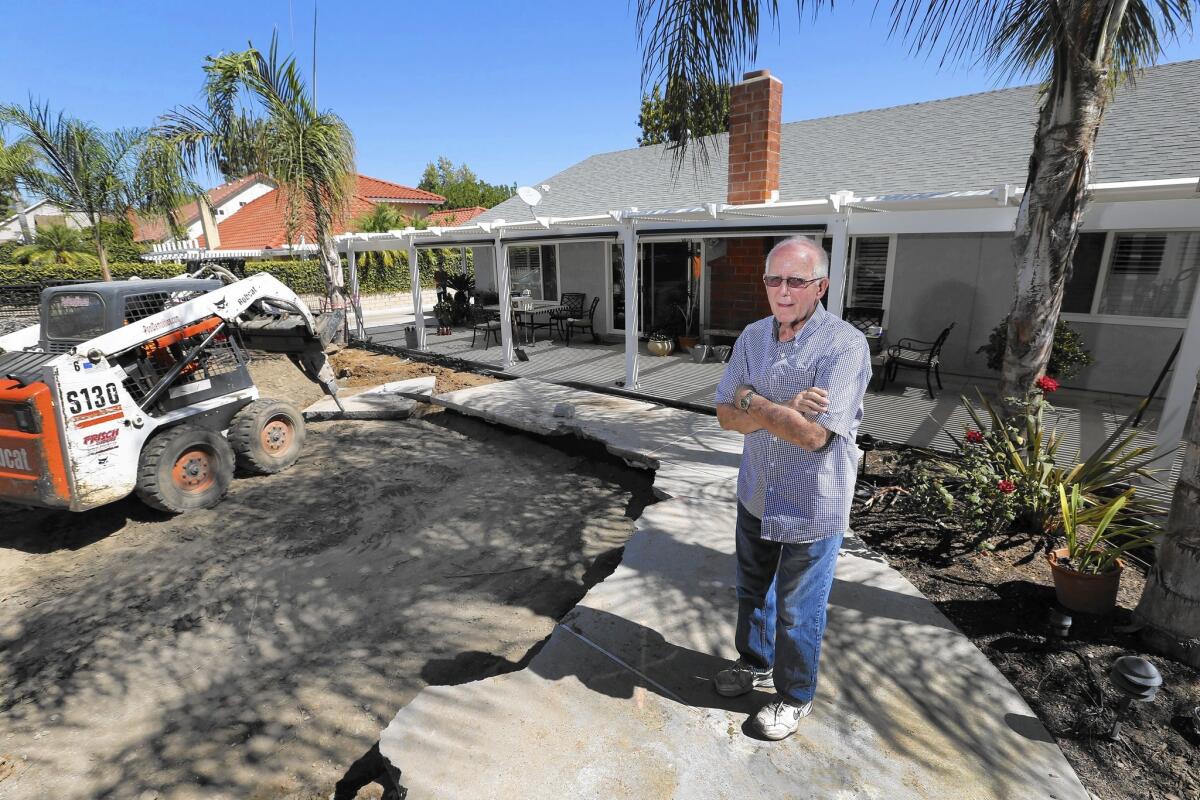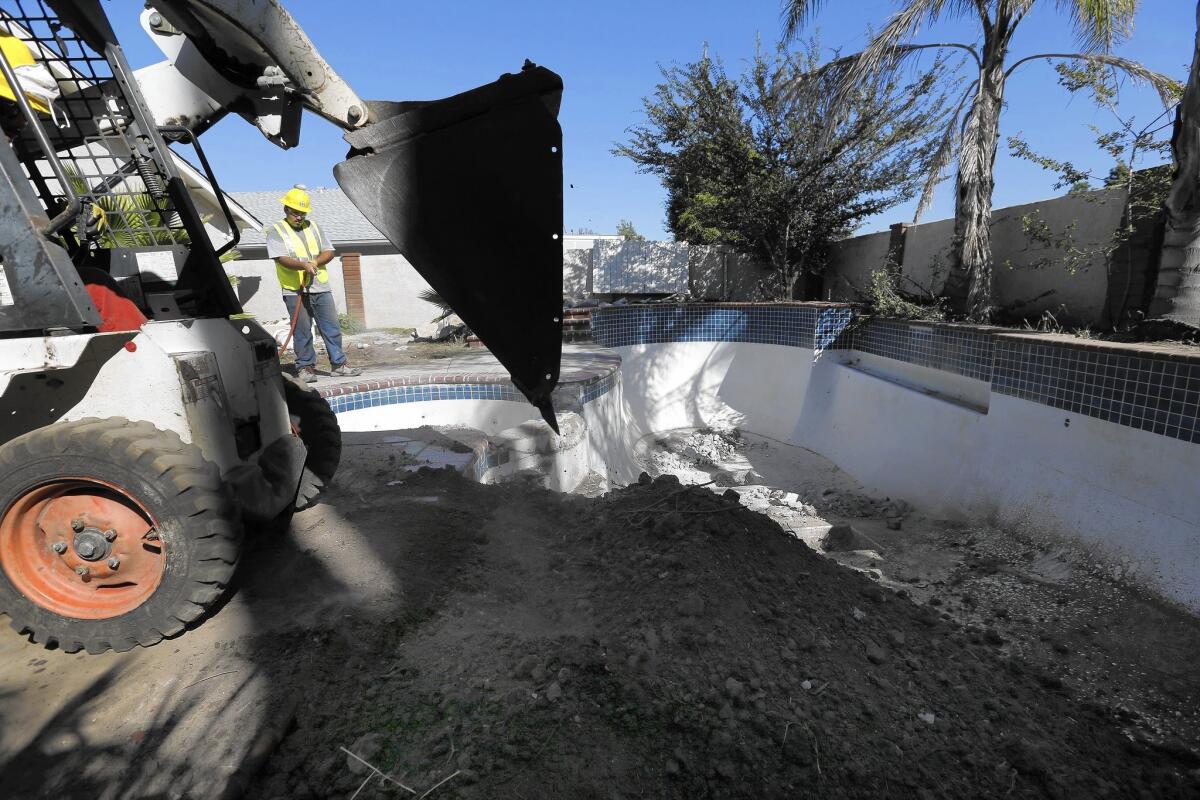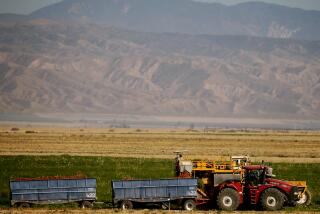Why some homeowners are no longer cool with backyard pools

Yorba Linda homeowner David Harms watches as the former pool in his backyard is filled. He’s replacing the pool with artificial grass and pavers.
- Share via
For more than 25 years, a kidney-shaped pool sparkled behind Paul Chen’s Cerritos home.
But last month, Chen joined a growing group of Southern Californians who have paid thousands of dollars to swap their backyard oasis for what Chen acknowledges is an “ugly” pile of dirt.
“The drought was my main concern,” said Chen, a 71-year-old retired sales executive. “You have to keep replenishing the water. Of course we can afford it, but you feel it’s unfair. … And you definitely feel a little guilty.”
Water and Power is The Times’ guide to the drought. Sign up to get the free newsletter >>
As California enters a potential fifth year of drought, the swimming pool demolition industry — a niche, to be sure — is thriving, operators say, with new companies entering the business to profit from Californians’ concerns about water scarcity.
And although conservation isn’t always the top reason to get rid of a pool, demolition specialists say the drought is responsible for an increasing share of business inquiries. One company owner said he has a backlog of a dozen pool demolition jobs. Another said he expects to do 80 jobs this year, compared with about 30 in 2012.
“Someone may have had [pool demolition] in their minds for a number of years, but the drought is the trigger that pushes it forward,” said that owner, Dave Frisch, whose company is based in Orange. “Now they have a good reason to do it.”
Pools have long stood as a symbol of the California lifestyle. A 2013 analysis counted more than 43,000 swimming pools in the L.A. basin alone. Increasingly however, the baby boomers who bought many of those homes are aging and their pools have become a safety hazard.
Several former pool owners said their children grew up, moved out and visit less. Over time, they said, cracks infiltrated the pool shells and mysterious leaks began popping up more frequently.
Then there was the drought to consider.
Water experts say well-maintained pools and their surrounding hardscapes use about the same amount of water as a lawn of the same size. Covers cut down on evaporation and can make pools significantly less wasteful than grass.
Local water agencies have urged pool owners to fix their leaks and use covers. Some cities and towns have placed limits on how often pools can be refilled or have banned construction of new pools.
Meanwhile, the price of water has gone up significantly over the last decade, and several water agencies have passed or are asking for a rate increase.
These factors have helped nudge dozens of homeowners to get their pools drained and filled in.
In each of the last three years, more than 50 homeowners have pulled permits for pool demolition in unincorporated parts of Los Angeles County, officials said. Sixty have applied for permits so far this year — up from 55 in 2014 and 53 in 2013. From 2010 to 2012, the county issued no more than 21 permits in a single year.
The picture is less stark in other parts of the region, however. Orange County Public Works officials said they have given out 19 permits this year, compared with 32 last year. The city of Los Angeles has given out only 15 permits total since October 2008.
But that hasn’t stopped some construction companies from trying to seize on concerns about water availability and wade into the pool demolition business.
About 2 1/2 years ago, Scott Choppin created a separate division of his demolition company to focus exclusively on pools. S.K. Choppin Demolition has seen that business almost double this year over last, he said.
“People’s decision to remove a pool is, based on my experience, life events — sell a house, kids move away — or ‘I’m the main person whose duty it is to take care of the pool and I’m tired of it,’ ” Choppin said. “But now we are seeing people specifically say, ‘My water rates are going up.’ …The drought piece is bigger and growing.”
Philip Merkel decided to have his pool taken out in August.
The 67-year-old law professor came to Huntington Beach in the 1990s after having lived in Chicago and “always thought it would be great” to have a house with a pool. But Merkel and his family didn’t use it much, and in recent years, the idea of “having a yard back” became more and more appealing, he said.
“The drumbeat of drought brought it to immediate attention,” he said. “But there were other factors too: the cost of upkeep; my nieces and nephews don’t come around as much anymore. … All those ideas were jelling.”

Andrew Casillas uses a loader to fill in a swimming pool while Jeremy Chavez waters down the dirt to help solidify it in a Yorba Linda backyard.
The job cost Merkel about $9,000. But he said he was paying about $1,200 a year for pool maintenance and an extra $50 a month on his energy bill to keep water circulating and clean. “You can pay one way or the other,” he said.
For some homeowners, though, the decision to fill in a pool had little to do with drought.
On a recent weekday afternoon in Yorba Linda, David Harms, 76, looked on as a machine operator set his skid steer’s hammer on what was formerly a piece of pool decking.
Over and over, the giant needle lifted into the air and then came crashing down on the concrete, puncturing it into a set of smaller pieces.
“The last year or so, the concrete started lifting around the deck, the pool got a crack in it, and I knew it was leaking,” Harms said. “So we decided to let it go.”
Twitter: @ByMattStevens
ALSO:
In the drought-parched Central Valley, a waiting game begins
California mudslides and chaos offer a preview of what El Niño could bring
Drought takes toll on ‘agritourism’ farms that once thrived on Halloween crowds
More to Read
Sign up for Essential California
The most important California stories and recommendations in your inbox every morning.
You may occasionally receive promotional content from the Los Angeles Times.











